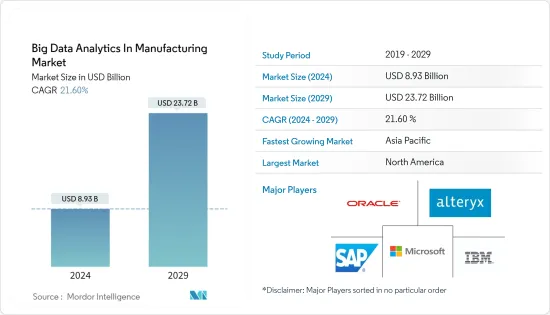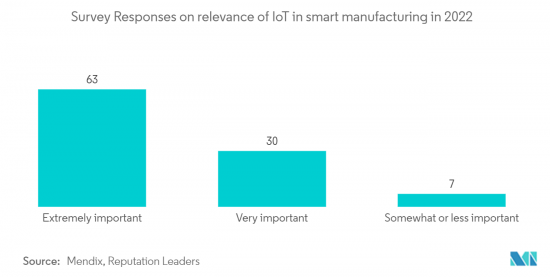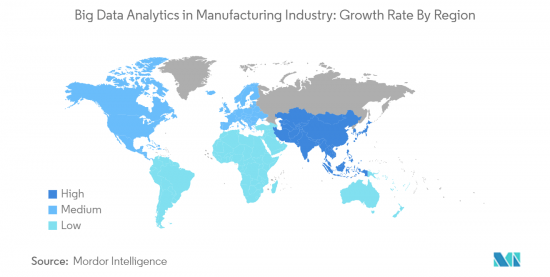 |
市場調査レポート
商品コード
1429469
製造業におけるビッグデータ分析:市場シェア分析、産業動向と統計、成長予測(2024年~2029年)Big Data Analytics In Manufacturing - Market Share Analysis, Industry Trends & Statistics, Growth Forecasts (2024 - 2029) |
||||||
● お客様のご希望に応じて、既存データの加工や未掲載情報(例:国別セグメント)の追加などの対応が可能です。 詳細はお問い合わせください。
| 製造業におけるビッグデータ分析:市場シェア分析、産業動向と統計、成長予測(2024年~2029年) |
|
出版日: 2024年02月15日
発行: Mordor Intelligence
ページ情報: 英文 120 Pages
納期: 2~3営業日
|
- 全表示
- 概要
- 目次
製造業におけるビッグデータ分析市場規模は2024年に89億3,000万米ドルと推定され、2029年には237億2,000万米ドルに達すると予測され、予測期間中(2024-2029年)のCAGRは21.60%で成長する見込みです。

製造業では、複雑なワークフローを効率的に処理するために人工知能(AI)技術の採用が進んでいます。世界のIoT、製造市場は2030年までに1兆5,000億米ドルに達すると予測されており、製品のライフサイクル全体とタイムリーな納品に影響を与え、計画外の停止、欠陥、安全性の問題を防ぐため、十分な情報に基づく意思決定は製造業者にとって極めて重要です。インテリジェント・ドキュメント・プロセッシング(IDP)などのAIソリューションは、非構造化および半構造化情報をリアルタイムで使用可能なデータに変換することで、製造業者がドキュメント処理に費やす時間を最小限に抑えるのに役立ちます。
主なハイライト
- マッキンゼーのレポートによると、データ主導型のビジネスは、顧客を引き付ける可能性が23倍、利益を上げる可能性が19倍高いです。製造企業は、業務のさまざまな分野からデータを収集し、リアルタイムで可視化することで、データ分析を活用できます。例えば、シュナイダーエレクトリックは、Oracle Analytics Cloudに切り替えたことで、90%の完売データを収集し、自動的に分析・処理することができるようになった。このテクノロジーにより、データ収集のミスが減り、手作業によるデータ統合がなくなり、適時性と正確性が向上しました。
- 労働力管理の障害に取り組むために、製造業は人員配置、スケジューリング、トレーニング、生産性の課題を予測する必要があります。ビッグデータ企業は、製造組織がメンテナンスや修理のスケジュールを立て、ダウンタイムを削減し、生産性を向上させるのに役立つ予測分析ソリューションを提供しています。例えば、BMWはデータ分析ソリューションを使用して、自動車生産中の製品の品質を監視しています。BMWの製造部門に設置されたセンサーは、品質問題が大きな問題に発展する前に早期に気づくためのデータを提供しています。
- COVID-19の大流行は製造業を混乱させ、サプライチェーンと在庫の追跡を困難にしました。生産部門におけるこのようなハードルは、RFIDやバーコードスキャニングのような技術でビッグデータ分析プロバイダーと協力せざるを得なくしました。
- 製造業でビッグデータ分析を採用する際の主なハードルは、品質のフィルタリングプロセスが必要な大量のデータが利用可能であることです。さまざまな部門からのデータを統合し、1つの実体として機能させ、問題を即座に特定して解決する必要があります。AI技術とデータ分析を採用することで、製造業は業務を最適化し、生産性を向上させ、世界な競争力を維持することができます。
製造業におけるビッグデータ分析市場動向
コンディションモニタリングは大幅な成長の見込み
- コンディションモニタリングは、センサーを使用してデータを収集し、振動、音の異常、気流、電流などの重要な運転パラメーターを監視するプロセスです。このデータは、予測データ分析ソリューションによって使用され、機械の故障を事前に予測し、最終的にメンテナンスコストとダウンタイムの削減に貢献します。
- Mondas社は、エネルギープラントやビルサービス機器のメーカーにコンディションモニタリングプラットフォームを提供する企業です。同社のリアルタイム・モニタリング機能は、重大な問題に発展する前に不具合を検出することで、運用コストの削減に貢献しています。
- 2023年2月、ダブリンを拠点とするHoistechはCoreRFIDと提携し、ユーザーがあらゆる資産の状態を監視・報告できるアプリベースのビジュアル管理ツールを開発しました。このアプリは、携帯電話のGPSを使用してユーザーと資産の位置を自動的に特定し、ダッシュボードはすべての資産パフォーマンスの明確な概要を提供します。
- OMRON Technologiesは2022年4月、主に自動車やFMCG産業で使用されるヒーター機器用のコンディションモニタリング装置K7TMを発売しました。この装置は、既存の設備に簡単に取り付けることができ、機械の異常状態を検知することができます。装置の運転中にヒーターの抵抗値を自動測定し、ヒーターの劣化傾向を把握できるのが大きな特徴。
- 2022年3月、Guardhat社は作業員のコンディションモニタリングのための産業グレードのソリューションをリリースしました。このアプリケーションは、リアルタイムのモニタリングとイベントベースのアラートを支援し、熱、ガス、放射線、その他の災難にさらされることによる怪我や死亡さえも防ぐのに役立ちます。試験は金属生産施設で実施され、気温が華氏102度を超えたため作業員が過労状態になっているというアラートを受信し、負傷が発生する前に作業員を冷却しました。

アジア太平洋地域は最高の成長に
- アジア開発銀行(ADB)は、東南アジア(SEA)経済が2023年に4.7%成長すると予測する報告書を発表しました。ASEAN地域に大きな成長機会をもたらす分野のひとつが製造業であり、モノのインターネット(IoT)技術の採用は、この成長ポテンシャルをさらに高める可能性があります。
- 韓国、中国、日本、台湾、シンガポールなど、アジア太平洋(APAC)地域のいくつかの国は、特に電子機器の組み立てや半導体部品の生産など、製造業が盛んなことで知られています。これらの国々では、エレクトロニクスや半導体産業における業務改善のため、ビッグデータ分析の導入が進んでいます。
- IoT技術の導入とデータ分析を組み合わせることで、日常業務における車両事故、従業員の欠勤、事故、負傷など、さまざまな業務面をリアルタイムで把握できるようになります。これにより、製造業における円滑なオペレーションを促進し、効率を高めることができます。
- ベトナムの大手デジタルトランスフォーメーション・サービス・プロバイダーであるFPT Softwareと日本のIT企業であるSCSKは、自動車業界のOEM(相手先ブランド製造)やサプライヤー向けの包括的なソリューションを共同で発表しました。このプラットフォーム「MaaZ(Monozukuri Adaptive AUTOSAR)」は、製品の市場投入期間を短縮し、顧客の総所有コストを低減できる高効率なソリューションの提供を目指します。
- 東南アジア経済は2023年に製造業を中心に大きな成長が見込まれます。IoT技術とデータ分析の採用は、この分野の成長をさらに高める可能性があります。FPT SoftwareやSCSKなどの企業は、OEMやサプライヤーに先進的なソリューションを提供するために協力することで、自動車業界の革新と効率化を推進しています。

製造業におけるビッグデータ分析の概要
製造業ではアナリティクスソリューションとIoTの導入が急増しており、ビッグデータ分析プロバイダーに新たなビジネスチャンスをもたらしています。既存プレーヤーは、新規参入企業との競争に勝ち抜くために、市場の拡大に伴って製品ラインナップを拡充しています。データアナリティクスが競争力を発揮できる分野の1つに画像解析があり、製造企業が人間の目では識別が難しい微細なひび割れや傷などの欠陥を検出するのに役立っています。
2023年2月、米国のスマート・マニュファクチャリングに関する国立研究所であるCESMIIは、SASと提携し、製造部門全体で高度なアナリティクスを推進しています。スマート工場にアナリティクス・ソリューションを導入することで、デジタルトランスフォーメーションを推進し、生産品質と効率を高め、ビジネスの意思決定を改善することができます。SASの先行顧客の1社であるジョージア・パシフィックは、SASのクラウドネイティブ・ソリューションを利用して、計画外のダウンタイムを30%削減し、全体的な効率を10%改善しました。
2022年1月、インドのBharat Petroleum Corporation Limited(BPCL)は、すべての事業部門を単一の共有プラットフォームで統合する技術ソリューション「One BPCL」を立ち上げました。BPCLは、Salesforce Sales and Service CloudとTableau CRMのビジネスアナリティクスを導入し、営業担当者がリードを獲得し、オポチュニティ・パイプラインを監視し、より迅速に取引を完了できるようにしました。これらの先進技術を活用することで、BPCLは業務を合理化し、全体的な業績を向上させることを目指しています。
その他の特典:
- エクセル形式の市場予測(ME)シート
- 3ヶ月間のアナリスト・サポート
目次
第1章 エグゼクティブサマリー
第2章 市場洞察
- 市場概要
- 業界の魅力- ポーターのファイブフォース分析
- 買い手/消費者の交渉力
- 供給企業の交渉力
- 新規参入業者の脅威
- 代替品の脅威
- 競争企業間の敵対関係の強さ
- 業界バリューチェーン分析
- COVID-19の市場への影響評価
第3章 市場力学
- 市場促進要因
- 進化する技術、資産、エンジニアリング志向のバリューチェーン
- インダストリー4.0による急速な産業自動化
- 市場抑制要因
- 認識不足とセキュリティへの懸念
- 市場機会
- 予測分析ツールの使用の増加
- IIoTの採用増加
第4章 市場セグメンテーション
- エンドユーザー産業別
- 半導体
- 航空宇宙
- 自動車
- その他のエンドユーザー産業
- 用途別
- コンディションモニタリング
- 品質管理
- 在庫管理
- その他の用途
- 地域別
- 北米
- 米国
- カナダ
- 欧州
- 英国
- ドイツ
- フランス
- その他欧州
- アジア太平洋
- 中国
- 日本
- インド
- その他アジア太平洋地域
- ラテンアメリカ
- 中東・アフリカ
- 北米
第5章 競合情勢
- 企業プロファイル
- Alteryx Inc.
- IBM Corporation
- Knime AG
- Microsoft Corporation
- MicroStrategy Incorporated
- Oracle Corporation
- RapidMiner Inc.
- SAP SE
- SAS Institute Inc.
- Tibco Software Inc.(Alpine Data)
第6章 投資分析
第7章 投資分析市場の将来
The Big Data Analytics In Manufacturing Market size is estimated at USD 8.93 billion in 2024, and is expected to reach USD 23.72 billion by 2029, growing at a CAGR of 21.60% during the forecast period (2024-2029).

The manufacturing industry increasingly adopts artificial intelligence (AI) technologies to handle complex workflows efficiently. With the global IoT, manufacturing market projected to reach USD 1.5 trillion by 2030, informed decision-making is critical for manufacturers as it impacts the entire product life cycle and timely delivery and prevents unplanned outages, defects, or safety issues. AI solutions such as intelligent document processing (IDP) help manufacturers minimize time spent processing documents by turning unstructured and semi-structured information into usable data in real-time.
Key Highlights
- According to a McKinsey report, data-driven businesses are 23 times more likely to attract clients and 19 times more likely to be profitable. Manufacturing companies can leverage data analytics by collecting and visualizing data from various areas of their operations in real-time. Schneider Electric, for example, switched to Oracle Analytics Cloud, which helped collect 90% of its sell-out data and analyze and process it automatically. With this technology, data collection errors were reduced, manual data consolidation was eliminated, and timeliness and accuracy improved.
- To tackle workforce management obstacles, manufacturing organizations must predict staffing, scheduling, training, and productivity challenges. Big data companies provide Predictive Analytics Solutions that help manufacturing organizations schedule maintenance and repairs, reduce downtime, and increase productivity. BMW, for instance, uses a data analytics solution to monitor the quality of its products during the production of cars. The sensors installed in BMW's manufacturing unit provide data that can help recognize quality issues early before they become a major problem.
- The COVID-19 pandemic disrupted the manufacturing industry, making keeping track of the supply chain and inventory challenging. These hurdles in the production sector compelled organizations to collaborate with big data analytic providers for technologies like RFID and barcode scanning, which help track goods in dispatch and location of warehouses by sitting in the manufacturer's premises.
- The major hurdle in adopting big data analytics in the manufacturing industry is the availability of a large amount of data with a need for quality filtering processes. Data from different departments should integrate and work as one entity to identify and resolve problems immediately. By adopting AI technologies and data analytics, the manufacturing industry can optimize operations, increase productivity, and stay competitive globally.
Big Data Analytics In Manufacturing Market Trends
Condition Monitoring is Expected to Register a Significant Growth
- Condition monitoring is a process that involves the use of sensors to collect data and monitor crucial operating parameters such as vibrations, sound anomalies, airflow, and current. This data is then used by predictive data analytics solutions to predict machine failures before they happen, ultimately helping to reduce maintenance costs and downtime.
- Mondas is a company that provides a Condition Monitoring platform for manufacturers of energy plants and building services equipment. Their real-time monitoring functionality helps to lower operating costs by detecting defects before they become major problems.
- In February 2023, Dublin-based Hoistech partnered with CoreRFID to develop an app-based visual management tool that enables users to monitor and report on the condition of any asset. The app automatically geolocates the user and asset using the phone's GPS, while the dashboard provides a clear overview of all asset performance.
- In April 2022, OMRON Technologies launched K7TM, a condition monitoring device for heater equipment used primarily in the automotive and FMCG industries. These devices can be easily attached to existing equipment to detect abnormal machinery conditions. One of the key features of this device is the automatic measuring of the resistance of the heater during equipment operation to identify the deterioration tendency of the heater.
- In March 2022, Guardhat released an industrial-grade solution for worker condition monitoring. The application assists in real-time monitoring and event-based alerts to help prevent injury or even death from exposure to heat, gas, radiation, or any other calamity. The trials were conducted at a metal production facility, where the organization received alerts that workers were getting over-exerted as the temperatures exceeded 102°F and got them cooled off before any injury occurred.

Asia-Pacific to Witness Highest Growth
- The Asian Development Bank (ADB) has released a report forecasting that the Southeast Asian (SEA) economy will grow by 4.7% in 2023. One sector that presents vast opportunities for growth in the ASEAN region is manufacturing, and the adoption of the Internet of Things (IoT) technology can further enhance this growth potential.
- Several countries in the Asia-Pacific (APAC) region, such as South Korea, China, Japan, Taiwan, and Singapore, are known for their strong manufacturing industries, particularly in producing electronics assembly and semiconductor parts. These countries are increasingly adopting big data analytics to improve operations in the electronics and semiconductor industries.
- The implementation of IoT technology, combined with data analysis, can enable real-time insights into various operational aspects, such as vehicle mishaps, employee absences, accidents, and injuries, during daily operations. This can help facilitate smooth operations and enhance efficiency in the manufacturing industry.
- Vietnam's leading digital transformation services provider, FPT Software, and Japanese IT company SCSK have collaborated to launch a comprehensive solution for original equipment manufacturers (OEMs) and suppliers in the automotive industry. The platform, MaaZ (Monozukuri Adaptive AUTOSAR), aims to provide highly efficient solutions that can reduce the product's time to market and lower the total cost of ownership for customers.
- In summary, the Southeast Asian economy is expected to experience significant growth in 2023, particularly in the manufacturing industry. The adoption of IoT technology and data analysis can further enhance growth in this sector. Companies such as FPT Software and SCSK are driving innovation and efficiency in the automotive industry by collaborating to provide advanced solutions to OEMs and suppliers.

Big Data Analytics In Manufacturing Industry Overview
The manufacturing sector has seen a surge in adopting analytics solutions and IoT, presenting new opportunities for big data analytics providers. Existing players expand their product offerings as the market expands to compete with new entrants. One area where data analytics can provide a competitive edge is image analysis, which helps manufacturing companies detect defects such as minute cracks or scratches that are difficult to identify with the human eye.
In February 2023, the United States national institute on Smart Manufacturing, CESMII, partnered with SAS to promote advanced analytics across the manufacturing sector. Deploying analytics solutions in smart factories can drive digital transformation, enhance production quality and efficiency, and improve business decision-making. Georgia-Pacific, one of SAS's earlier clients, has experienced a 30% reduction in unplanned downtime and a 10% improvement in overall efficiency using SAS's cloud-native solution.
In January 2022, India's Bharat Petroleum Corporation Limited (BPCL) launched "One BPCL," a technology solution that unites all its business units under a single shared platform. BPCL deployed Salesforce Sales and Service Cloud and Tableau CRM's business analytics to help its sales officers capture leads, monitor opportunity pipelines, and close deals faster. By leveraging these advanced technologies, BPCL aims to streamline its operations and improve its overall business performance.
Additional Benefits:
- The market estimate (ME) sheet in Excel format
- 3 months of analyst support
TABLE OF CONTENTS
1 EXECUTIVE SUMMARY
2 MARKET INSIGHTS
- 2.1 Market Overview
- 2.2 Industry Attractiveness - Porter's Five Forces Analysis
- 2.2.1 Bargaining Power of Buyers/Consumers
- 2.2.2 Bargaining Power of Suppliers
- 2.2.3 Threat of New Entrants
- 2.2.4 Threat of Substitute Products
- 2.2.5 Intensity of Competitive Rivalry
- 2.3 Industry Value Chain Analysis
- 2.4 Assessment of the Impact of COVID-19 on the Market
3 MARKET DYNAMICS
- 3.1 Market Drivers
- 3.1.1 Evolving Technology, Asset, and Engineering-oriented Value Chain
- 3.1.2 Rapid Industrial Automation led by Industry 4.0
- 3.2 Market Restraints
- 3.2.1 Lack of Awareness and Security Concerns
- 3.3 Market Opportunities
- 3.3.1 Increasing Use of Predictive Analytics Tools
- 3.3.2 Increasing Adoption of IIoT
4 MARKET SEGMENTATION
- 4.1 By End-user Industry
- 4.1.1 Semiconductor
- 4.1.2 Aerospace
- 4.1.3 Automotive
- 4.1.4 Other End-user Industries
- 4.2 By Application
- 4.2.1 Condition Monitoring
- 4.2.2 Quality Management
- 4.2.3 Inventory Management
- 4.2.4 Other Applications
- 4.3 Geography
- 4.3.1 North America
- 4.3.1.1 United States
- 4.3.1.2 Canada
- 4.3.2 Europe
- 4.3.2.1 United Kingdom
- 4.3.2.2 Germany
- 4.3.2.3 France
- 4.3.2.4 Rest of the Europe
- 4.3.3 Asia-Pacific
- 4.3.3.1 China
- 4.3.3.2 Japan
- 4.3.3.3 India
- 4.3.3.4 Rest of the Asia Pacific
- 4.3.4 Latin America
- 4.3.5 Middle East and Africa
- 4.3.1 North America
5 COMPETITIVE LANDSCAPE
- 5.1 Company Profiles
- 5.1.1 Alteryx Inc.
- 5.1.2 IBM Corporation
- 5.1.3 Knime AG
- 5.1.4 Microsoft Corporation
- 5.1.5 MicroStrategy Incorporated
- 5.1.6 Oracle Corporation
- 5.1.7 RapidMiner Inc.
- 5.1.8 SAP SE
- 5.1.9 SAS Institute Inc.
- 5.1.10 Tibco Software Inc. (Alpine Data)
